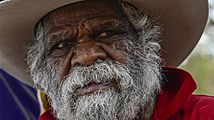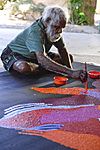Yannima Tommy Watson facts for kids
Quick facts for kids
Yannima Tommy Watson
|
|
|---|---|

Tommy Watson 2013
|
|
| Born |
Yannima Pikarli
Circa 1935 Anamarapiti, Western Australia
|
| Died | November 2017 |
| Known for | Painting |
| Movement | Contemporary Indigenous Australian art |
Yannima Tommy Watson, also known as Tommy Watson, was an amazing Indigenous Australian artist. He was born in the 1930s. Tommy was from the Pitjantjatjara people, who live in Australia's central western desert. One art expert even called him "the greatest living painter of the Western Desert".
Contents
Tommy Watson's Early Life
Tommy Yannima Pikarli Watson was an important elder and law man for the Pitjantjatara people. He was born around 1935 in a place called Anumarapiti. This area is about 75 kilometers west of Irrunytju in Western Australia. It is close to where Western Australia, the Northern Territory, and South Australia meet. His names, Yannima and Pikarli, are linked to special places near Anumarapiti.
Tommy's mother passed away when he was a baby. His father died when Tommy was about eight years old. After that, he lived with his father's brother, who also passed away two years later. Then, Tommy was adopted by Nicodemus Watson, who was his father's first cousin. This is when he went to live at Ernabella Mission. He also took the surname Watson, becoming Tommy Yannima Pikarli Watson.
Nicodemus Watson became a very important father figure to Tommy. They traveled a lot together. Tommy learned many traditional skills needed to live in the desert. He learned how to make tools and weapons from trees using hot coals. He also learned what to hunt, how to hunt, and where to find water. Nicodemus taught Tommy about nature and his people's ancient stories. These stories are known as Tjukurrpa to Aboriginal peoples.
Tommy Watson first met white Australians at the Ernabella Mission in South Australia. This mission opened in 1940. After a short time there, he went back to his community to take part in an important initiation ceremony. Tommy Watson's early life was similar to many Indigenous people born around that time. He lived a traditional nomadic life until his early teens. Later, he worked as a stockman and a laborer. While working at Papunya, he met a teacher named Geoffrey Bardon. Geoffrey helped start the Aboriginal art movement at the Papunya Tula art center.
Tommy Watson's Art Journey
Tommy Watson started painting in 2001. He was one of the first artists to help set up the Irrunytju community art center that same year.
His artwork quickly became very famous, both in Australia and around the world. Art experts compared his work to famous Western abstract painters. These included artists like Wassily Kandinsky and Mark Rothko. John MacDonald, a writer for The Sydney Morning Herald, said Tommy Watson was "a master of invention." He also called him "arguably the outstanding painter of the Western Desert." MacDonald even compared Tommy's use of color to the famous artist Henri Matisse.
In 2003, Tommy Watson was one of eight Indigenous artists chosen for a special project. They created artworks to decorate one of the buildings at the Musée du quai Branly in Paris, France. This museum was finished in 2006.
In early 2013, Tommy moved to Alice Springs to live with his family. His health improved, and he started painting again. He created very large artworks, some up to five meters long. Until the end of his life, his art was sold by Yanda Aboriginal Art and Piermarq. His large paintings from 2013 sold for over $800,000 each. One painting, called Ngayuku Ngura - Anumara Piti, sold for about $500,000.
In 2014, a huge painting by Tommy Watson was shown at The European Fine Art Fair (TEFAF). This is one of the most important art fairs in the world. His work was also part of a group show in Sydney in 2014.
Also in 2014, the Art Series Hotel Group named a hotel after Tommy Watson. This hotel, called The Watson, is in Adelaide. It features many high-quality copies of his amazing artworks.
Tommy Watson's Painting Style
Tommy Watson was famous for using bright, strong colors in his paintings. These colors were not just pretty; they also told the ancient stories of his land. Judith Ryan, a senior curator at the National Gallery of Victoria, said Tommy's colors were "incandescent," meaning they seemed to glow.
Tommy understood Australia's natural environment very well. He also knew the ancestral stories connected to it. These two things became the main ideas in his paintings. He painted on high-quality Belgian linen and preferred a special type of acrylic paint. Tommy was also linked to the 'Colour Power' art movement. This movement grew within the Indigenous art scene between 1984 and 2004.
Tommy Watson himself said that his art explored traditional Aboriginal culture. He explained that the land and spirituality are deeply connected in his culture. These connections are passed down through stories from one generation to the next. He once said, "I want to paint these stories so that others can learn and understand about our culture and country."
Where to See His Art
Tommy Watson's artworks are held in many important collections around the world. These include:
- Art Gallery of New South Wales
- National Gallery of Australia
- National Gallery of Victoria
- Musee du Quai Branly, Paris
- Art Gallery of Western Australia
- South Australian Art Gallery
- Museum and Art Gallery of the Northern Territory
- Bega Valley Regional Gallery
- Colin Laverty Collection
- Patrick Corrigan Collection
- Auscorp Collection
- Kerry Stokes Collection
Images for kids


